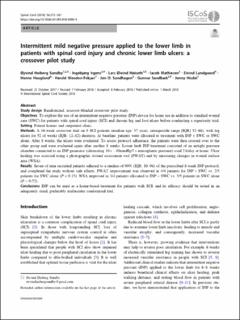| dc.contributor.author | Sundby, Ø. H. | |
| dc.contributor.author | Irgens, I. | |
| dc.contributor.author | Høiseth, L. Ø. | |
| dc.contributor.author | Mathiesen, J. | |
| dc.contributor.author | Lundgaard, E. | |
| dc.contributor.author | Haugland, H. | |
| dc.contributor.author | Weedon-Fekjær, H. | |
| dc.contributor.author | Sundhagen, J. O. | |
| dc.contributor.author | Sandbæk, G. | |
| dc.contributor.author | Hisdal, J. | |
| dc.date.accessioned | 2021-07-09T11:32:34Z | |
| dc.date.available | 2021-07-09T11:32:34Z | |
| dc.date.issued | 2018 | |
| dc.identifier.citation | Sundby, Ø. H., Irgens, I., Høiseth, L. Ø., Mathiesen, J., Lundgaard, E., Haugland, H., Weedon-Fekjær, H. … Hisdal, J. (2018). Intermittent mild negative pressure applied to the lower limb in patients with spinal cord injury and chronic lower limb ulcers: a crossover pilot study. Spinal Cord, 56(4), 372–381. | en_US |
| dc.identifier.uri | https://hdl.handle.net/11250/2764049 | |
| dc.description.abstract | Study design
Randomized, assessor-blinded crossover pilot study.
Objectives
To explore the use of an intermittent negative pressure (INP) device for home use in addition to standard wound care (SWC) for patients with spinal cord injury (SCI) and chronic leg and foot ulcers before conducting a superiority trial.
Setting
Patient homes and outpatient clinic.
Methods
A 16-week crossover trial on 9 SCI patients (median age: 57 years, interquartile range [IQR] 52–66), with leg ulcers for 52 of weeks (IQR: 12–82) duration. At baseline, patients were allocated to treatment with INP + SWC or SWC alone. After 8 weeks, the ulcers were evaluated. To assess protocol adherence, the patients were then crossed over to the other group and were evaluated again after another 8 weeks. Lower limb INP treatment consisted of an airtight pressure chamber connected to an INP generator (alternating 10 s −40mmHg/7 s atmospheric pressure) used 2 h/day at home. Ulcer healing was assessed using a photographic wound assessment tool (PWAT) and by measuring changes in wound surface area (WSA).
Results
Seven of nine recruited patients adhered to a median of 90% (IQR: 80–96) of the prescribed 8-week INP-protocol, and completed the study without side effects. PWAT improvement was observed in 4/4 patients for INP + SWC vs. 2/5 patients for SWC alone (P = 0.13). WSA improved in 3/4 patients allocated to INP + SWC vs. 3/5 patients in SWC alone (P = 0.72).
Conclusions
INP can be used as a home-based treatment for patients with SCI, and its efficacy should be tested in an adequately sized, preferably multicenter randomized trial. | en_US |
| dc.publisher | Spinal Cord | en_US |
| dc.subject | circulation | en_US |
| dc.subject | outcomes research | en_US |
| dc.subject | clinical trial design | en_US |
| dc.subject | trykksår | en_US |
| dc.subject | pasientsikkerhet | en_US |
| dc.title | Intermittent mild negative pressure applied to the lower limb in patients with spinal cord injury and chronic lower limb ulcers: a crossover pilot study | en_US |
| dc.type | Journal article | en_US |
| dc.source.pagenumber | 372–381 | en_US |
| dc.source.volume | 56 | en_US |
| dc.source.journal | Spinal Cord | en_US |
| dc.source.issue | 4 | en_US |
| dc.identifier.doi | https://doi.org/10.1038/s41393-018-0080-4 | |
| dc.description.localcode | måsjekkes | |
